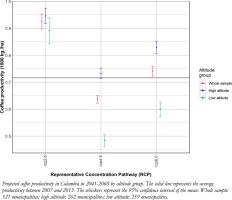Agricultural Systems ( IF 6.1 ) Pub Date : 2021-03-14 , DOI: 10.1016/j.agsy.2021.103126 Federico Ceballos-Sierra , Sandy Dall'Erba

|
Context
Coffee is one of the trademarks of Colombia. Currently, up to a half million Colombian families depend directly on coffee production for their livelihoods. As such, there has been increasing concerns about how coffee productivity will react to changing climate conditions and how coffee growers could adapt their production practices.
Objective
This paper is one of the first to estimate the production function of Colombian coffee at the municipal level and to make projections about its future productivity.
Methods
Using a panel dataset measured across municipalities over 2007–2013, we find that productivity depends on altitude as well as on March temperature and precipitation. We estimate projections based on the 2.6, 4.5, and 6.0 Representative Concentration Pathways derived from Global Circulation Models.
Results and conclusions
We find that productivity over 2041–2060 is expected to increase by 7.6% on average. However, we find that this forecast varies greatly according to altitude. Indeed, municipalities above median elevation will increase their productivity by 16%, while those below the median will experience a 8.1% decrease in productivity.
Significance
Our result implies that place-tailored strategies for coffee production in Colombia are required to adapt to changing climate conditions in the future.
中文翻译:

气候变化对哥伦比亚咖啡生产率的影响:动态面板模型方法
语境
咖啡是哥伦比亚的商标之一。目前,多达五十万哥伦比亚家庭直接依靠咖啡生产为生。因此,人们越来越担心咖啡的生产率如何应对气候变化以及咖啡种植者如何适应他们的生产方式。
客观的
本文是第一批评估哥伦比亚咖啡在市政一级的生产功能并对其未来生产率进行预测的报告之一。
方法
使用2007-2013年间在各个城市进行测量的面板数据集,我们发现生产力取决于海拔以及三月的温度和降水量。我们根据从全球流通模型得出的2.6、4.5和6.0代表性浓度路径估算预估值。
结果与结论
我们发现2041年至2060年的生产率预计将平均提高7.6%。但是,我们发现此预测会根据海拔高度而有很大差异。实际上,海拔中位数以上的城市的生产率将提高16%,而海拔中位数以下的城市的生产率将下降8.1%。
意义
我们的结果表明,哥伦比亚需要针对咖啡生产采取量身定制的策略,以适应未来不断变化的气候条件。











































 京公网安备 11010802027423号
京公网安备 11010802027423号